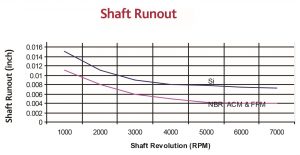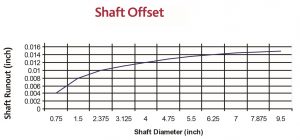Oil Seals Shaft and Bore Configurations and Tolerances
Shaft and Bore Configurations
Shaft Material
Seals perform best on medium carbon steel or stainless steel shaft. Heat treatment or nitriding is especially recommended. To seal water at low surface velocities, stainless steel is more suitable.
The minimum hardness on the area where the sealing lip contacts the shaft should be 45 HRC. Where lubrications is doubtful, abrasive matter is present, or shaft speed is greater than 4m/sec, 55 HRC is preferred.
The shaft must be machined to the surface Roughness of Rt=1 to 4 micrometers (Ra=0.2 to 0.8 micrometers). In the areas of the contact surface, any rifling marks are not permitted.
Shaft Tolerance
| Nominal Shaft Diameter | Tolerance |
| up to 4.000 | +/- 0.003 |
| over 4.000 to 6.000 | +/- 0.004 |
| over 6.000 to 10.000 | +/- 0.005 |
| over 10.000 | +/- 0.006 |
| Shaft Material and Hardness | ||
| Condition | Material | Hardness |
| General | Carbon steel (Heat treatment or nitriding is especially recommended) |
45 HRC min. |
| For sealing water with low surface velocity | Stainless steel | 55 HRC min. |
Configuration of the Bore
The leading corner of the bore should be chamfered and free of burrs. The inside corner of the bore should have a maximum radius of 0.047”. The tolerances for the bore are shown below.
| Bore Tolerance in inches | |
| Bore Diameter | Bore Tolerance |
| up to 3.000 | +/- 0.001 |
| 3.001 to 6.000 | +/- 0.0015 |
| 6.001 to 10.000 | +/- 0.002 |
| 10.001 to 20.000 | +/- 0.002/- 0.004 |
| 20.001 to 40.000 | +/- 0.002/- 0.006 |
| 40.001 to 60.000 | +/- 0.002/- 0.010 |
Bore Material
Steel and cast iron provide a good surface for both rubber O.D. and metal O.D. seals. For soft alloy (aluminum) bore, seals with rubber O.D. provide better sealing capacity than metal O.D.
The table below shows the recommended maximum bore roughness.
| Bore I.D. Roughness | Maximum Roughness |
| Metal O.D. | 10 microinches Ra 2.50 microinches Ra |
| Rubber covered O.D. | 150 microinches Ra 3.75 microinches Ra |
Shaft Eccentricity
Two types of shaft eccentricity effect seal performance. They are dynamic runout (double dynamic eccentricity) and offset (shaft to bore misalignment or static eccentricity).
The accompanying graphs show tolerance levels for each type.
Shaft Runout

Shaft Offset

